The nurse is applying standard precautions by performing which of the following? ✅ 2023
Thủ Thuật về The nurse is applying standard precautions by performing which of the following? Chi Tiết
Lê Nguyễn Hà Linh đang tìm kiếm từ khóa The nurse is applying standard precautions by performing which of the following? được Update vào lúc : 2022-11-03 09:20:09 . Với phương châm chia sẻ Bí quyết Hướng dẫn trong nội dung bài viết một cách Chi Tiết Mới Nhất. Nếu sau khi đọc Post vẫn ko hiểu thì hoàn toàn có thể lại phản hồi ở cuối bài để Admin lý giải và hướng dẫn lại nha.Open Resources for Nursing (Open RN)
Nội dung chính Show- Interventions to Break the Chain of InfectionDisinfection and SterilizationStandard and Transmission-Based PrecautionsStandard PrecautionsTransmission-Based PrecautionsAseptic and Sterile TechniquesOther Hygienic Patient Care InterventionsWhich action of the nurse demonstrates the use of standard precautions?For which of the following would it be most appropriate for a nurse to use a centimeter scale ruler for measurement?Which of the following techniques are used in a physical assessment select all that apply?What should the nurse do immediately before performing any procedure?
In addition to recognizing signs of infection and educating patients about the treatment of their infection, nurses also play an important role in preventing the spread of infection. A cyclic process known as the chain of infection describes the transmission of an infection. By implementing interventions to break one or more links in the chain of infection, the spread of infection can be stopped. See Figure 9.16[1] for an illustration of the links within the chain of infection. These links are described as the following:
- Infectious Agent: A causative organism, such as bacteria, virus, fungi, parasite.Reservoir: A place where the organism grows, such as in blood, food, or
a wound.Portal of Exit: The method by which the organism leaves the reservoir, such as through respiratory secretions, blood, urine, breast milk, or feces.Mode of Transmission: The vehicle by which the organism is transferred such as physical contact, inhalation, or injection. The most common vehicles are respiratory secretions spread by a cough, sneeze, or on the hands. A single sneeze can send thousands of virus particles into the air.
Portal of Entry: The method by which the organism enters a new host, such as through mucous membranes or nonintact skin.Susceptible Host: The susceptible individual the organism has
invaded.[2]
 Figure 9.16 Chain of Infection
Figure 9.16 Chain of InfectionFor a pathogen to continue to exist, it must put itself in a position to be transmitted to a new host, leaving the infected host through a portal of exit. Similar to portals of entry, the most common portals of exit include the skin and the respiratory, urogenital, and gastrointestinal tracts. Coughing and sneezing can expel thousands of pathogens from the respiratory tract into the environment. Other pathogens are expelled through feces, urine, semen, and vaginal secretions. Pathogens that rely on insects for transmission exit the body toàn thân in the blood extracted by a biting insect.[3]
The pathogen enters a new individual via a portal of entry, such as mucous membranes or nonintact skin. If the individual has a weakened immune system or their natural defenses cannot fend off the pathogen, they become infected.
Interventions to Break the Chain of Infection
Infections can be stopped from spreading by interrupting this chain any link. Chain links can be broken by disinfecting the environment, sterilizing medical instruments and equipment, covering coughs and sneezes, using good hand hygiene, implementing standard and transmission-based precautions, appropriately using personal protective equipment, encouraging patients to stay up-to-date on vaccines (including the flu shot), following safe injection practices, and promoting the optimal functioning of the natural immune system with good nutrition, rest, exercise, and stress management.
Disinfection and Sterilization
and are used to kill microorganisms and remove harmful pathogens from the environment and equipment to decrease the chance of spreading infection. Disinfection is the removal of microorganisms. However, disinfection does not destroy all spores and viruses. Sterilization is a process used on equipment and the environment to destroy all pathogens, including spores and viruses. Sterilization methods include steam, boiling water, dry heat, radiation, and chemicals. Because of the harshness of these sterilization methods, skin can only be disinfected and not sterilized.[4]
Standard and Transmission-Based Precautions
To protect patients and health care workers from the spread of pathogens, the CDC has developed precautions to use during patient care that address portals of exit, methods of transmission, and portals of entry. These precautions include standard precautions and transmission-based precautions.
Standard Precautions
Standard precautions are used when caring for all patients to prevent healthcare-associated infections. According to the Centers for Disease Control and Prevention (CDC), are the minimum infection prevention practices that apply to all patient care, regardless of suspected or confirmed infection status of the patient, in any setting where health care is delivered. These precautions are based on the principle that all blood, body toàn thân fluids (except sweat), nonintact skin, and mucous membranes may contain transmissible infectious agents. These standards reduce the risk of exposure for the health care worker and protect the patient from potential transmission of infectious organisms.[5] See Figure 9.17[6] for an image of some of the components of standard precautions.
Current standard precautions according to the CDC include the following:
- Appropriate hand hygieneUse of personal protective equipment
(e.g., gloves, gowns, masks, eyewear) whenever infectious material exposure may occurAppropriate patient placement and care using transmission-based precautions when indicatedRespiratory hygiene/cough etiquetteProper handling and cleaning of environment, equipment, and devicesSafe handling of laundrySharps safety (i.e., engineering and work practice controls)Aseptic technique for invasive nursing procedures such as parenteral medication
administration[7]
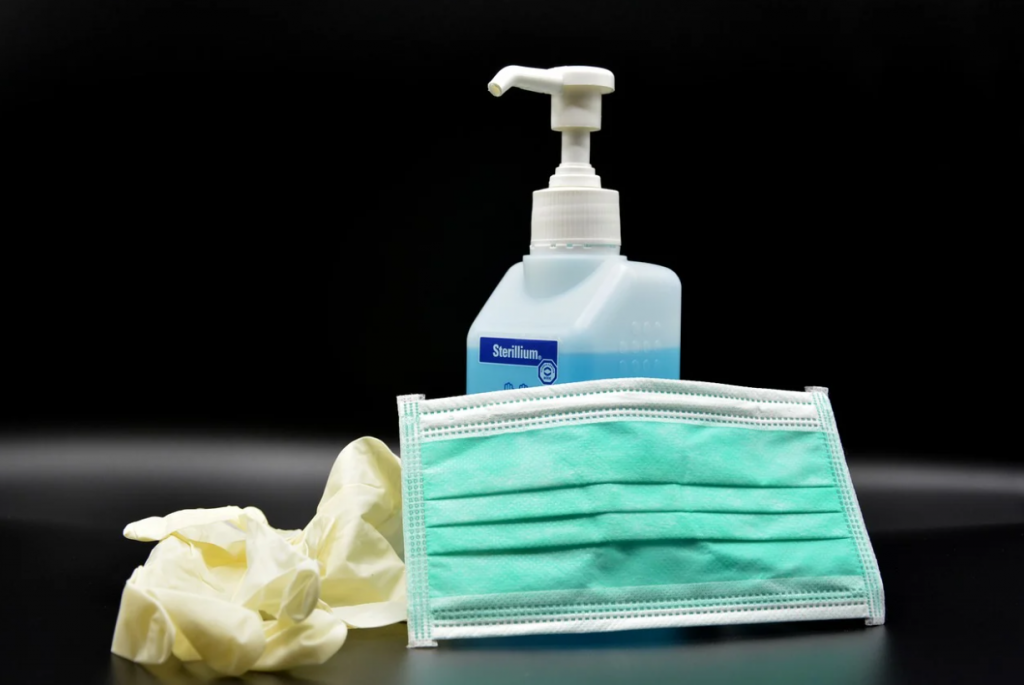 Figure 9.17 Components of Standard PrecautionsHand Hygiene
Figure 9.17 Components of Standard PrecautionsHand HygieneHand hygiene, although simple, is still the best and most effective way to prevent the spread of infection. The 2022 National Patient Safety Goals from The Joint Commission encourages infection prevention strategy practices such as implementing the hand hygiene guidelines from the Centers for Disease Control.[8] Accepted methods for hand hygiene include using either soap and water or alcohol-based hand sanitizer. It is essential for all health care workers to use proper hand hygiene the appropriate times, such as the following:
- Immediately before touching a patientBefore performing an aseptic task or handling invasive devicesBefore moving from a soiled body toàn thân site to a clean body toàn thân site on a patientAfter touching a patient or their immediate environmentAfter contact with blood, body toàn thân fluids, or contaminated surfaces (with or without glove use)Immediately after glove removal[9]
Hand hygiene also includes health care workers keeping their nails short with tips less than 0.5 inches and no nail polish. Nails should be natural, and artificial nails or tips should not be worn. Artificial nails and chipped nail polish have been associated with a higher level of pathogens carried on the hands of the nurse despite hand hygiene.[10]
Read more about using appropriate hand hygiene in the “Aseptic Technique” chapter in Open RN Nursing Skills.
Respiratory Hygiene/Cough EtiquetteRespiratory hygiene is targeted patients, accompanying family members and friends, and staff members with undiagnosed transmissible respiratory infections. It applies to any person with signs of illness, including cough, congestion, or increased production of respiratory secretions when entering a health care facility. The elements of respiratory hygiene include the following:
- Education of health care facility staff, patients, and visitorsPosted signs, in language(s) appropriate to the population served, with instructions to patients and accompanying family members or friendsSource control measures for a coughing person (e.g., covering the mouth/nose with a tissue
when coughing and prompt disposal of used tissues, or applying surgical masks on the coughing person to contain secretions)Hand hygiene after contact with one’s respiratory secretionsSpatial separation, ideally greater than 3 feet, of persons with respiratory infections in common waiting areas when
possible[11]
Health care personnel are advised to wear a mask and use frequent hand hygiene when examining and caring for patients with signs and symptoms of a respiratory infection. Health care personnel who have a respiratory infection are advised to stay home or avoid direct patient contact, especially with high-risk patients. If this is not possible, then a mask should be worn while providing patient care.[12]
Personal Protective Equipmentincludes gloves, gowns, face shields, goggles, and masks used to prevent the spread of infection to and from patients and health care providers. See Figure 9.18[13] for an image of a nurse wearing PPE. Depending upon the anticipated exposure and type of pathogen, PPE may include the use of gloves, a fluid-resistant gown, goggles or a face shield, and a mask or respirator. When used while caring for a patient with transmission-based precautions, PPE supplies are typically stored in an isolation cart next to the patient’s room.
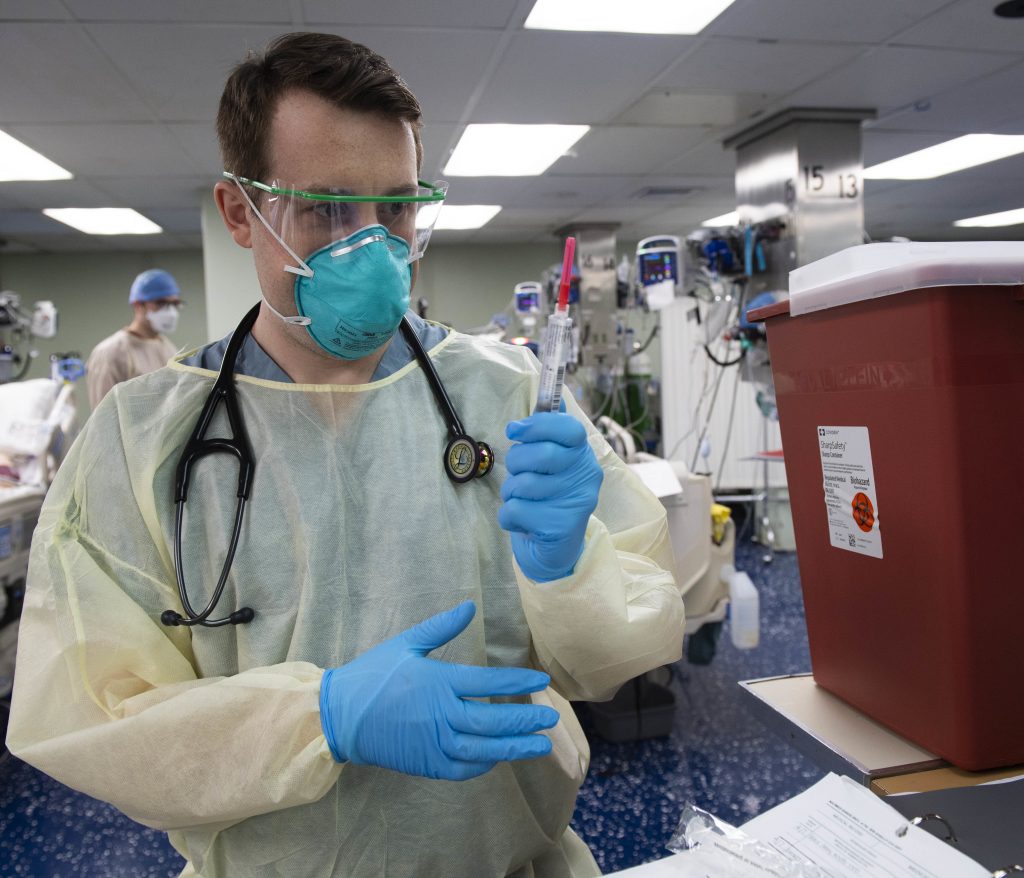 Figure 9.18 Personal Protective Equipment
Figure 9.18 Personal Protective EquipmentRead more about how to properly use personal protective equipment in the “Aseptic Technique” chapter in Open RN Nursing Skills.
Transmission-Based Precautions
In addition to standard precautions, transmission-based precautions are used for patients with documented or suspected infection of highly-transmissible pathogens, such as C. difficile (C-diff), Methicillin-resistant Staphylococcus aureus (MRSA), Vancomycin-resistant enterococci (VRE), Respiratory Syncytial Virus (RSV), measles, and tuberculosis (TB). For patients with these types of pathogens, standard precautions are used along with specific transmission-based precautions.[14]
There are three categories of transmission-based precautions: contact precautions, droplet precautions, and airborne precautions. Transmission-based precautions are used when the route(s) of transmission of a specific disease are not completely interrupted using standard precautions alone.
Some diseases, such as tuberculosis, have multiple routes of transmission so more than one transmission-based precaution category must be implemented. See Table 9.6 outlining the categories of transmission precautions with associated PPE and other precautions. When possible, patients with transmission-based precautions should be placed in a single occupancy room with dedicated patient care equipment (e.g., blood pressure cuffs, stethoscope, and thermometer stay in the patient’s room). A card is posted outside the door alerting staff and visitors to required precautions before entering the room. See Figure 9.19[15] for an example of signage used for a patient with contact precautions. Transport of the patient and unnecessary movement outside the patient room should be limited. When transmission-based precautions are implemented, it is also important for the nurse to make efforts to counteract possible adverse effects of these precautions on patients, such as anxiety, depression, perceptions of stigma, and reduced contact with clinical staff.[16]
Table 9.6 Transmission-Based Precautions[17]
PrecautionImplementationPPE and Other PrecautionsContactKnown or suspected infections with increased risk for contact transmission (e.g., draining wounds, fecal incontinence) or with epidemiologically important organisms, such as C-diff, MRSA, VRE, or RSV Gloves
Gown
Dedicated equipment
Limit patient transport out of room
Prioritized disinfection of the room
Note: Use only soap and water for hand hygiene in patients with C. difficile infection.
DropletKnown or suspected infection with pathogens transmitted by large respiratory droplets generated by coughing, sneezing, or talking, such as influenza or pertussis MaskGoggles or face shield
AirborneKnown or suspected infection with pathogens transmitted by small respiratory droplets, such as measles and coronavirus Fit-tested N-95 respiratorAirborne infection isolation room
Single-patient room
Patient door closed
Restricted susceptible personnel room entry
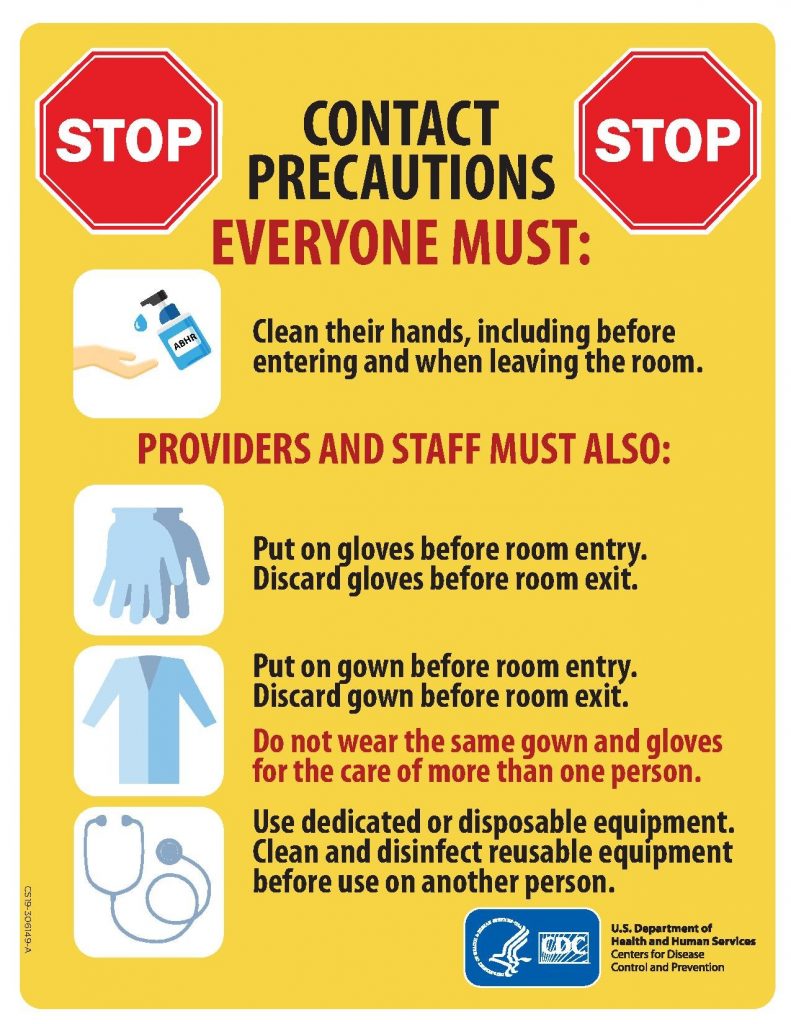 Figure 9.19 Contact Precautions Sign
Figure 9.19 Contact Precautions SignView a list of Transmission Based Precautions for specific medical conditions on the CDC’s Infection Control web page.
Patient TransportSeveral principles are used to guide transport of patients requiring transmission-based precautions. In the inpatient and residential settings, these principles include the following:
- Limit
transport for essential purposes only, such as diagnostic and therapeutic procedures that cannot be performed in the patient’s roomWhen transporting, use appropriate barriers on the patient consistent with the route and risk of transmission (e.g., mask, gown, covering the affected areas when infectious skin lesions or drainage is present)Notify health care personnel in the receiving area of the impending arrival of the patient and of the precautions necessary to prevent
transmission[18]
Enteric precautions are used when there is the presence, or suspected presence, of gastrointestinal pathogens such as Clostridium difficile (C-diff) or norovirus. These pathogens are present in feces, so health care workers should always wear a gown in the patient room to prevent inadvertent fecal contamination of their clothing from contact with contaminated surfaces.
In addition to contact precautions, enteric precautions include the following:
- Using only soap and water for hand hygiene. Do not use hand sanitizer because it is not effective against C-diff.Using a special disinfecting process. Special disinfecting should be used after patient discharge and includes disinfection of the mattress.
Reverse isolation, also called neutropenic precautions, is used for patients who have compromised immune systems and low neutrophil levels. This type of isolation protects the patient from pathogens in their environment. In addition to using contact precautions to protect the patient, reverse isolation precautions include the following:
- Meticulous hand hygiene by all visitors, staff, and the patientFrequently monitoring for signs and symptoms of infection and sepsisNot allowing live plants, fresh flowers, fresh raw fruits or vegetables, sushi, deli foods, or cheese into the room due to bacteria and fungiPlacement in a private room
or a positive pressure roomLimited transport and movement of the patient outside of the roomMasking of the patient for transport with a surgical
mask[19]
Read additional information about Neutropenia and Risk for Infection.
Psychological Effects of IsolationAlthough the use of transmission-based precautions is needed to prevent the spread of infection, it is important for nurses to be aware of the potential psychological impact on the patient. Research has shown that isolation can cause negative impact on patient mental well-being and behavior, including higher scores for depression, anxiety, and anger among isolated patients. It has also been found that health care workers spend less time with patients in isolation, resulting in a negative impact on patient safety.[20]
Patient and family education the time of instituting transmission-based precautions is a critical component of the process to reduce anxiety and distress. Patients often feel stigmatized when placed in isolation, so it is important for them to understand the rationale of the precautions to keep themselves and others không lấy phí from the spread of disease. Preparing patients emotionally will also help decrease their anxiety and help them cope with isolation.[21] It is also important to provide distractions from boredom, such as music, television, video games, magazines, or books, as appropriate.
Aseptic and Sterile Techniques
In addition to using standard precautions and transmission-based precautions, (also called medical asepsis) is used to prevent the transfer of microorganisms from one person or object to another during a medical procedure. For example, a nurse administering parenteral medication or performing urinary catheterization uses aseptic technique. When performed properly, aseptic technique prevents contamination and transfer of pathogens to the patient from caregiver hands, surfaces, and equipment during routine care or procedures. It is important to remember that potentially infectious microorganisms can be present in the environment, on instruments, in liquids, on skin surfaces, or within a wound.[22]
There is often misunderstanding between the terms aseptic technique and sterile technique in the health care setting. Both asepsis and sterility are closely related with the shared concept being the removal of harmful microorganisms that can cause infection. In the most simplistic terms, aseptic technique involves creating a protective barrier to prevent the spread of pathogens, whereas sterile technique is a purposeful attack on microorganisms. (also called surgical asepsis) seeks to eliminate every potential microorganism in and around a sterile field while also maintaining objects as không lấy phí from microorganisms as possible. Sterile fields are implemented during surgery, as well as during nursing procedures such as the insertion of a urinary catheter, changing dressings on open wounds, and performing central line care. See Figure 9.20[23] for an image of a sterile field during surgery. Sterile technique requires a combination of meticulous hand washing, creating and maintaining a sterile field, using long-lasting antimicrobial cleansing agents such as Betadine, donning sterile gloves, and using sterile devices and instruments.[24]
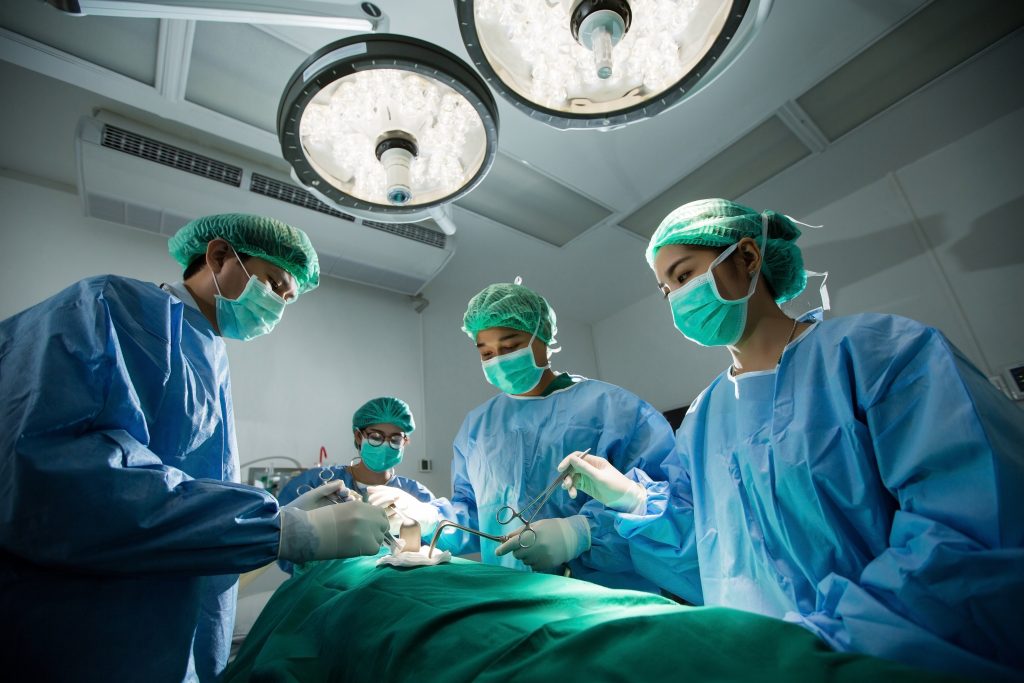 Figure
9.20 Surgical Asepsis
Figure
9.20 Surgical AsepsisRead additional information about aseptic and sterile technique in the “Aseptic Technique” in Open RN Nursing Skills.
Read a continuing education article about Sterile Technique and surgical scrubbing.
Other Hygienic Patient Care Interventions
In addition to implementing standard and transmission-based precautions and utilizing aseptic and sterile technique when performing procedures, nurses implement many interventions to place a patient in the best health possible to prevent an infection or treat infection. These interventions include actions like encouraging rest and good nutrition, teaching stress management, providing good oral care, encouraging daily bathing, and changing linens. It is also important to consider how gripper socks, mobile devices, and improper glove usage can contribute to the transmission of pathogens.
Oral CarePatient hygiene is important in the prevention and spread of infection. Although oral care may be given a low priority, research has found that poor oral care is associated with the spread of infection, poor health outcomes, and poor nutrition. Oral care should be performed in the morning, after meals, and before bed.[25]
Daily BathingDaily bathing is another intervention that may be viewed as time-consuming and receive low priority, but it can have a powerful impact on decreasing the spread of infection. Studies have shown a significant decrease in healthcare-associated infections with daily bathing using chlorhexidine gluconate (CHG) wipes or solution. The use of traditional soap and water baths do not reduce infection rates as significantly as CHG products, and wash basins have also been shown to be a reservoir for pathogens.[26]
LinensChanging bed linens, towels, and a gown regularly eliminates potential reservoirs of bacteria. Fresh linens also promote patient comfort.
Gripper SocksHave you ever thought about what happens to the bed linens when a patient returns from a walk in the hallway with gripper socks and gets back into bed with these socks? Research demonstrates that pathogens from the floor are transferred to the patient bed linens from the gripper socks. Nurses should remove gripper socks that were used for walking before patients climb into bed. They should also throw the socks away when the patient is discharged instead of sending them home.[27]
Cellular Phones and Mobile DevicesResearch has shown that cell phones and mobile devices carry many pathogens and are dirtier than a toilet seat or the bottom of a shoe. Patients, staff, and visitors routinely bring these mobile devices into health care facilities, which can cause the spread of disease. Nurses should frequently wipe mobile devices with disinfectant. They should encourage patients and visitors to disinfect phones frequently and avoid touching the face after having touched a mobile device.[28]
GlovesAlthough gloves are used to prevent the spread of infection, they can also contribute to the spread of infection if used improperly. For example, research has shown that hand hygiene opportunities are being missed because of the overuse of gloves. For example, a nurse may don gloves to suction a patient but neglect to remove them and perform hand hygiene before performing the next procedure on the same patient. This can potentially cause the spread of secondary infection. The World Health Organization (WHO) states that gloves should be worn when there is an expected risk of exposure to blood or body toàn thân fluids or to protect the hands from chemicals and hazardous drugs, but hand hygiene is the best method of disease prevention and is preferred over wearing gloves when the exposure risk is minimal. Nurses have the perception that wearing gloves provides extra protection and cleanliness. However, the opposite is true. Nonsterile gloves have a high incidence of contamination with a range of bacteria, which means that a gloved hand is dirtier than a washed hand. Research has shown that nearly 40% of the times that gloves are used in patient care, there is cross contamination. The most striking example of cross contamination includes situations when gloves are used for toileting a patient and not being removed before touching other surfaces or the patient.[29],[30],[31]
Glove-related contact dermatitis has also become an important issue in recent years as more and more nurses are experiencing damage to the hands. Contact dermatitis can develop from repeated use of gloves and develops as dry, itchy, irritated areas on the skin of the hands. See Figure 9.21[32] for an image of contact dermatitis from gloves. Because the skin is the first line of defense in preventing pathogens from entering the body toàn thân, maintaining intact skin is very important to prevent nurses from exposure to pathogens.
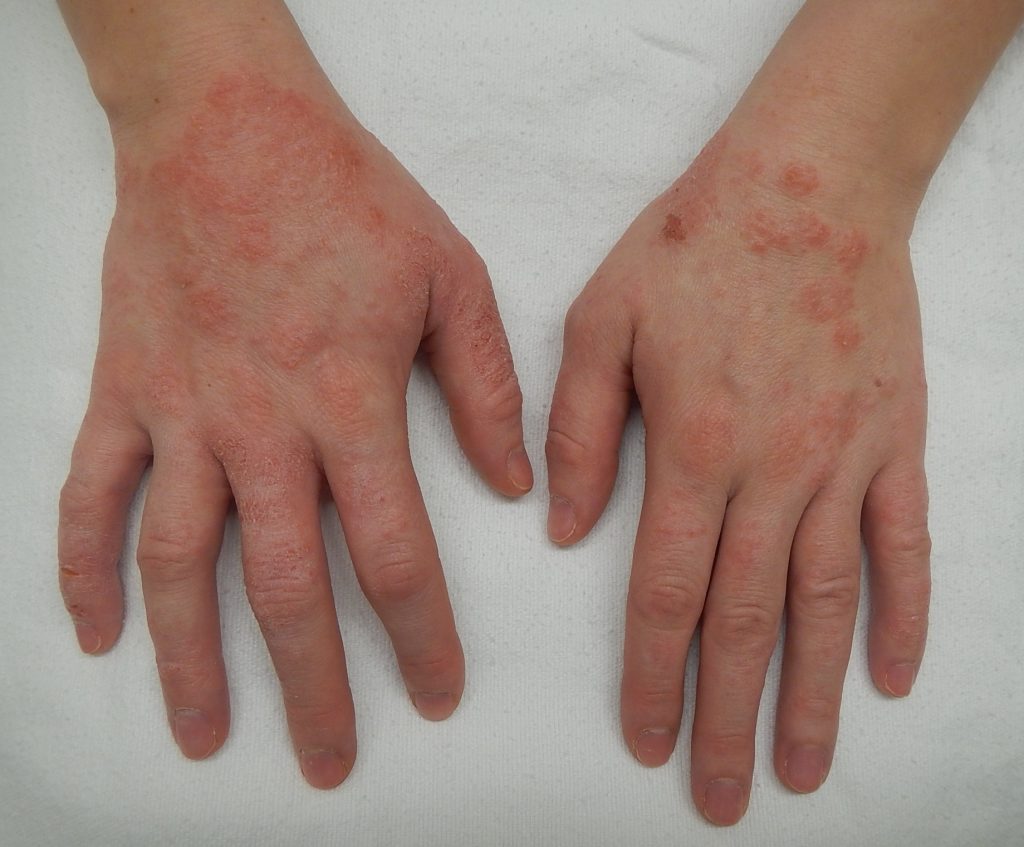 Figure
9.21 Contact Dermatitis
Figure
9.21 Contact Dermatitis
Which action of the nurse demonstrates the use of standard precautions?
Which action by a nurse demonstrates the correct application of the principles of standard precautions? The nurse is conducting a physical examination of the abdomen. What is the nurse's best action to ensure she can hear bowel sounds? Reduce all environmental noise.For which of the following would it be most appropriate for a nurse to use a centimeter scale ruler for measurement?
Terms in this set (44) It would be most appropriate for a nurse to use a centimeter-scale ruler for which measurement? Explanation: A centimeter scale rule most likely would be used to measure the size of a skin lesion.Which of the following techniques are used in a physical assessment select all that apply?
The four basic methods or techniques that are used for physical assessment are inspection, palpation, percussion and auscultation.What should the nurse do immediately before performing any procedure?
Before performing a procedure, what should the nurse do first:. Raise the patient's bed to it highest position.. Collect the equipment for the procedure.. Position the client for the procedure.. Explain the procedure to the client.. Tải thêm tài liệu liên quan đến nội dung bài viết The nurse is applying standard precautions by performing which of the following? Standard precautions Hand hygiene